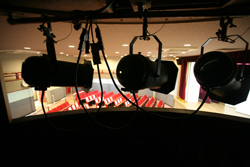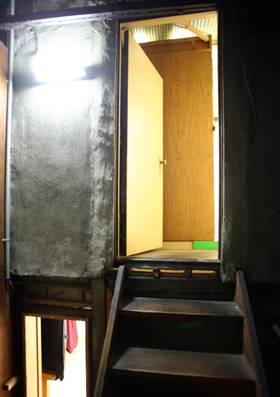
About the attic
This is a room where Beat Takeshi (Takeshi Kitano) used to live in. When he came to this hall, he had no money and clothes. There were times when he wore a costume for plays because he had no clothes. Those minor performers, including Takeshi Kitano, used to sit in a circle and drank alcohol, encouraging each other in this windowless room. If futon mattresses were laid out in this room, 2-3 minor performers could be slept, so they were always stationed here.
(continued in the lower column)

The stage of Toyokan
This is the stage of Toyokan. Takeshi Kitano appeared on the stage.
Q: The audience seats are very close. How many audiences can be seated?
Yes, audience seats are close. So it is easy for performers to play. They can directly see faces of audiences. There are 200 seats.

Q: When I saw old pictures and picture postcards, I noticed that there were many movie theaters in this neighborhood. Does this area have not much to do with Okuyama?
This area was called "a street of movie theaters in Rokku (Asakusa District No. 6)." There were many movie theaters on both sides of the street. The street led to Okuyama. Kenichi Enomoto performed his first play at Okuyama.
Q: Did Ryounkaku (Asakusa Junikai) stand in the vicinity?
Ryounkaku was located at the end of this street. It was on the same side of the street as Hanayashiki. Now a pachinko parlor stood on the site. High-rise buildings have built one after the other in this neighborhood, so the townscape has significantly changed.
Q: I heard that Asakusa District No. 6 has currently been redeveloped.
I am not sure it is redevelopment, but a variety of stores and businesses have opened in that area. For example, pachinko parlors and hotels have opened. Asakusa District No. 6 had changed a lot through the Meiji and Taisho to early Showa Periods, and around 1960 when movies declined.
Q: Taking advantage of the redevelopment, you try to attract visitors, including tourists from abroad who visit Asakusa, don't you?
Yes, it is. I think it is good for them to tour around Asakusa and visit this area. One attraction in not enough. We need to prepare a variety of attractions.
Q: Did people visit Senso-ji Temple, and played at Okusama on their way home in the Edo Period?
In the Edo Period, there were Kabuki theaters at Saruwaka-cho located beyond Senso-ji Temple. Those theaters were what were called "Saruwaka Sanzas." Saruwaka Sanzas were large theaters. It is said that, besides Saruwaka Sanzas, there were about 20 theaters of various sizes. Some people went to Yoshiwara after visiting those theaters. There were theaters and Yoshiwara, so I think that area was the most lively place in the Edo Period. (continued in the right column)
Q: I heard that there was Hyotan Pond in Asakusa District No. 6.
The area around Hyotan Pond was a swampland. Senso-ji Temple was also a chessman-shaped small building called "Komando," where a restaurant specializing in loach dishes is now located. Later, Tenkai, a Buddhist priest of the highest rank, turned the hill of Ueno, which was the hill of the Nichiren sect of Buddhism at that time, into the hill of the Tendai sect of Buddhism. On that occasion, Senso-ji Temple (Komando) was moved to the present place because it was located in the unlucky direction when seen from the Edo Castle. It was the beginning of Senso-ji Temple. Since then, Asakusa has thrived. The time when Asakusa Park was developed, the area was divided into seven sections, and many playhouses were built in the Meiji Period, and the time when there were Asakusa operas, and moving picture theaters were built in the Taisho Period are the most prosperous periods in Asakusa. There were many film narrators in this area, but most of them lost their jobs when talking films appeared. Then, Kenichi Enomoto and Roppa Furukawa appeared on the scene, and turned Asakusa into the center of the art of making people laugh.
Q: Shinsuke Minami appeared later, didn't he? Was it the time when Dassen Trio was active before Tempuku Trio appeared?
Shinsuke Minami appeared long after them. It was after the Second World War. How did you ever know old Dassen Trio (Toru Yuri, Toshiaki Minami, and Mutoshi Happa)?
Q: Tenpuku Trio appeared after Dassen Trio, and then Conte Akashingo, didn't they?
Conte Akashingo was also a trio. At that time, comedy skits played by several performers were popular. Most of them were trios. It was the time when Akireta Boys was popular. Akireta Boys (Kiton Masuda, Kyu Sazanka, Saburo Boya, Toshihide Shiba, and Yoshio Kawada) took the world by storm.
Q: What entertainments other than Rakugo comic storytelling are now performed in Asakusa Engei Hall?
Rakugo comic storytelling, comic chats, silhouette cutting shows, lion dances with jugglery, and others are now performed in this hall. As to lion dances with jugglery, there is "Daikagura Kyokugei Kyokai," or lion dance with jugglery stunt association.
Q: Are those lion dancers and jugglers are trained here?
Young lion dancers and jugglers are trained in the National Theater of Japan. Musical accompanists, such as samisen players, and stunt performers are also trained in the National Theater of Japan. I feel grateful about it.
Q: Do they come to this hall after being trained in the National Theater of Japan?
Yes, they are trained in the National Theater of Japan, and then assigned to each association. It is carried out by the country. I much appreciate it.
Q: Are types of performances predetermined?
There is a small entertainment hall in the National Theater of Japan. Traditional entertainers, including samisen players, lion dances and jugglers, are trained in that hall.
Q: Comic-chat artistes and Rakugo comic storytellers are not trained, are they?
There is no place to train them. For example, some young people come to this hall, saying that they want to be a Rakugo comic storyteller, but we do not train them. If they do not apprentice themselves to any Rakugo comic storyteller, they cannot be a Rakugo comic storyteller. It is a conventional practice, so I introduce those young people to Rakugo comic storytellers. As to comic dialogues and comedy skits, there are associations, such as Manzaikyokai and Tokyo-engeikyokai, so young people who have a reasonable degree of ability choose to belong to such associations.









